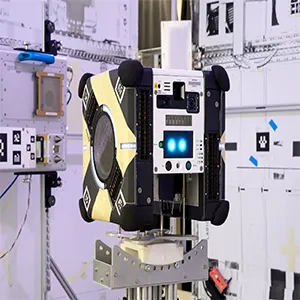
Meet Astrobee: NASA's autonomous robot assistants floating alongside astronauts
Robots that float, watch, and help keep a spaceship running are no longer science fiction. NASA’s Astrobee robots glide through the International Space Station using quiet fan thrusters, cameras, and smart software to handle chores that do not need a human touch.
NASA has expanded access to this robotic platform through a new partnership so more groups can test space tech in real orbital conditions.
The three cube shaped robots, Bumble, Honey, and Queen, and their docking station form a flexible lab that supports industry and academic users as NASA confirms on its Astrobee overview.
Jose Benavides, project manager for the Astrobee facilities at NASA’s Ames Research Center, leads operations that turn the free flyers into reliable helpers for crew and researchers.
His team at Ames builds tools, schedules test sessions, and supports outside experiments that ride on the robots.
How Astrobee moves
Each robot is about 12.5 inches wide and propels itself with electrically driven fans that work well in microgravity. The robots snap into a docking station to recharge and to offload data so they are ready for the next task.
Astrobee estimates where it is and where it is going using visual inertial navigation, a guidance system that combines camera images with motion sensors to calculate position and movement.
That navigation – plus markerless vision, autonomous docking, and a perching arm – is documented in a 2018 software paper.
The perching arm lets the robot pause and stay in place without using power, an important feature for long surveys.
The software stack is modular and built on the Robot Operating System, an open-source framework used by engineers to program and control robots, so guest scientists can add payloads and algorithms for experiments.
What the robots do each day
On a typical session the robots act as mobile sensor platforms to inspect equipment, record video, or carry small hardware between modules. They also serve as a safe testbed for autonomy and guidance in tight indoor spaces.
Across its first years on orbit, the facility completed more than 130 test sessions and passed 1,000 hours of operations, and the robots can execute hours-long autonomous flight plans or be run by operators on the ground through teleoperation.
Those numbers show steady use, not a one off demo, the kind of record that builds researchers’ trust in the platform.
“There’s a reason so many science fiction stories have a beloved robot alongside the human heroes, we know we can’t explore space alone. We’re showing that humans and robotic systems can collaborate and support powerful science and engineering beyond Earth,” said Benavides.
NASA needs partnerships
Astrobee is designed as a facility, not just a one time mission, so outside groups can upload code and bolt on new sensors within strict safety rules.
That approach gives NASA a low risk way to try fresh ideas without taking time from astronaut schedules.
Public private partnerships are central to this model and include a formal Space Act Agreement, a legal framework that allows NASA to work with outside organizations on shared research goals.
Arkisys is the current commercial partner to help sustain and maintain the platform so more experiments can get on the calendar.
“Dozens of institutions collaborate with NASA to use the Astrobee system to test new hardware and software technologies. I’m excited to hear how respondents think Astrobee can continue to advance robotics in space,” said Benavides.
How a session actually unfolds
Before a run, operators load a mission plan that includes a map of the station interior, safety limits for speed, and thrust boundaries.
Astronauts set up the work area and give the go ahead, then the robot leaves the dock and begins its route.
Cameras and depth sensors feed the navigation system and the controller adjusts the fan nozzles to follow the plan or stop if anything looks wrong.
When batteries run low or the plan ends, the robot returns to the dock and the data syncs to the ground.

Why Astrobee matters
Astrobee is not just a camera with thrusters, it is a research platform that produces results other teams can build on.
A recent peer-reviewed article reported on tests of a gecko inspired adhesive gripper carried by Astrobee to enable perching and gentle grasping on smooth panels in orbit.
These studies turn lab concepts into flight validated methods for future spacecraft care. The outcomes inform software design, sensor choices, and maintenance strategies for vehicles that may spend months without crew.
Spacecraft need regular inspections and quick checks after small anomalies, and robots can perform these tasks without pulling an astronaut off science.
Free flyers also let engineers rehearse future operations for missions that cannot count on crew being present all the time.
Longer trips to the Moon and Mars will lean on reliable autonomy inside pressurized habitats. Astrobee shows how to build that reliability step by step, with verified navigation, safe planning, and simple interfaces for crew and ground teams.
Astrobee flies only inside the station and obeys tight safety limits on speed, force, and proximity to people and equipment. Those limits are not a weakness, they make it possible to run many experiments without risk.
Next steps include more capable manipulation, better mapping, and smarter scheduling so robots can share the work. The point is steady progress, adding capabilities that make life easier for crew while opening new doors for research.
—–
Like what you read? Subscribe to our newsletter for engaging articles, exclusive content, and the latest updates.
Check us out on EarthSnap, a free app brought to you by Eric Ralls and Earth.com.
—–













